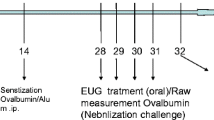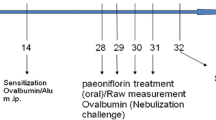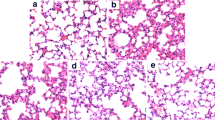Abstract
Many plant species containing flavonoids have been widely used in traditional Chinese medicine. Naringin, a well-known flavanone glycoside of citrus fruits, possesses antioxidant, anti-inflammatory, anti-apoptotic, anti-ulcer, anti-osteoporosis, and anti-carcinogenic properties. The aim of the study was to investigate the anti-asthmatic effects of naringin and the possible mechanisms. Asthma model was established by ovalbumin. A total of 50 mice were randomly assigned to five experimental groups: control, model, and dexamethasone (2 mg/kg, orally) and naringin (5 mg/kg, 10 mg/kg, orally). Airway resistance (Raw) were measured, histological studies were evaluated by the hematoxylin and eosin (HE) staining, OVA-specific serum and BALF IgE levels and Th1/Th2 cytokines were evaluated by enzyme-linked immunosorbent assay (ELISA), and Th1/Th2 cells was evaluated by flow cytometry (FCM). T-bet and GABA3 in the lung were evaluated by Western blot. Our study demonstrated that naringin inhibited OVA-induced increases in Raw and eosinophil count; OVA-induced effects on interleukin (IL)-4 and INF-gamma levels were blunted with naringin administration. Histological studies demonstrated that naringin substantially inhibited OVA-induced eosinophilia in lung tissue and airway tissue. Flow cytometry studies demonstrated that naringin substantially inhibited Th2 cells and enhanced Th1 cells. Naringin substantially inhibited GABA3 and increased T-bet. These findings suggest that naringin may effectively ameliorate the progression of asthma and could be used as a therapy for patients with allergic asthma.










Similar content being viewed by others
References
Beasley, R., J. Crane, C.K. Lai, and N. Pearce. 2000. Prevalence and etiology of asthma. Journal of Allergy and Clinical Immunology 105: 466–72.
Busse, W.W., and R.F. Lemanske Jr. 2001. Asthma. New England Journal of Medicine 344: 350–62.
Mosmann, T.R., and K.W. Moore. 1991. The role of IL-10 in cross regulation of TH1 and TH2 responses. Immunology Today 12: A49–A53.
Brewer, J.M., M. Conacher, C.A. Hunter, M. Mohrs, F. Brombacher, and J. Alexander. 1999. Aluminium hydroxide adjuvant initiates strong antigen-specific Th2 responses in the absence of IL-4-or IL-13-mediated signaling. Journal of Immunology 163: 6448–6454.
Lin, B.Q., P.B. Li, Y.G. Wang, W. Peng, Z. Wu, W.W. Su, et al. 2008. The expectorant activity of naringenin. Pulmonary Pharmacology & Therapeutics 21: 259–63.
Gao, S., P.B. Li, H.L. Yang, S.Q. Fang, and W.W. Su. 2011. Antitussive effect of naringin on experimentally induced cough in guinea pigs. Planta Medica 77: 16–21.
Shi, Y., J. Dai, H. Liu, R.R. Li, P.L. Sun, Q. Du, et al. 2009. Naringenin inhibits allergen-induced airway inflammation and airway responsiveness and inhibits NF-kappaB activity in a murine model of asthma. Canadian Journal of Physiology and Pharmacology 87: 729–35.
Liu, Y., H. Wu, Y.C. Nie, J.L. Chen, W.W. Su, and P.B. Li. 2011. Naringin attenuates acute lung injury in LPS-treated mice by inhibiting NF-kappaB pathway. International Immunopharmacology 11: 1606–12.
Oh, S.R., M.Y. Lee, K. Ahn, B.Y. Park, O.K. Kwon, H. Joung, et al. 2006. Suppressive effect of verproside isolated from Pseudolysimachion longifolium on airway inflammation in a mouse model of allergic asthma. International Immunopharmacology 6: 978–86.
Djukanovic, R., W.R. Roche, and J.W. Wilson. 1990. Mucosal inflammation in asthma. American Review of Respiratory Disease 142: 434–57.
Duan, W., J.H. Chan, and C.H. Wong. 2004. Anti inflammatory effects of mitogen-activated protein kinase inhibitor U0126 in an asthma mouse model. The Journal of Immunology 172: 7053–7059.
Jain, V.V., K. Kitagaki, T. Businga, I. Hussain, C. George, P. O’shaughnessy, et al. 2002. CpG-oligodeoxynucleotides inhibit airway remodeling in a murine model of chronic asthma. Journal of Allergy and Clinical Immunology 110: 867e72.
Wenzel, S.E. 2006. Asthma: defining of the persistent adult phenotypes. Lancet 368: 804–13.
Elsner, J., and A. Kapp. 1999. Regulation and modulation of eosinophil effector functions. Allergy 54: 15–26.
Acknowledgments
This work was supported by a Project Funded by the Priority Academic Program Development of Jiangsu Higher Education Institutions.
Author information
Authors and Affiliations
Corresponding author
Rights and permissions
About this article
Cite this article
Guihua, X., Shuyin, L., Jinliang, G. et al. Naringin Protects Ovalbumin-Induced Airway Inflammation in a Mouse Model of Asthma. Inflammation 39, 891–899 (2016). https://doi.org/10.1007/s10753-016-0321-7
Published:
Issue Date:
DOI: https://doi.org/10.1007/s10753-016-0321-7




